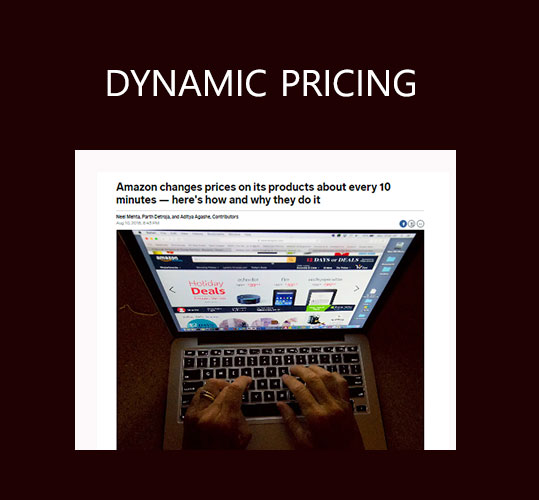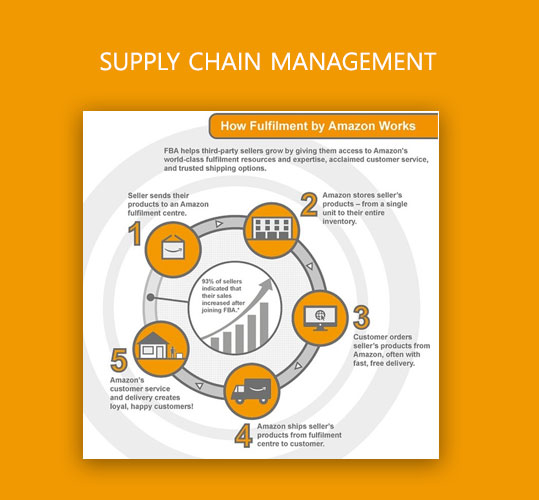When the conversation starts about ecommerce, the first name that strikes everyone’s mind is Amazon. It’s not an overnight success for sure; it took 25 years for Amazon to be a brand of everyone’s choice across the globe.
Our shopping habits are changing, and we are more accustomed to searching for products online, even more on mobile devices. It’s a general practice; before purchasing any product, we often check the price of that product on ecommerce marketplaces. There are a handful of brands on whom you trust for national as well as international buys, and Amazon is one of them.
Wait! What do you think the magic has happened that Amazon knows your preference for products and brands better than you do?
Well, that’s the magic wand that Amazon uses to captivate customers and gain their attention. The name of that magic wand is BIG DATA!
Amazon’s logo tells its entire story that it covers all the product categories from A-to-Z. A lot of customers are sure to come when you have all the things available under one roof. A huge count of users means a lot of data!
A huge team of data analysts and data scientists are employed by Amazon to analyze the big data and present it to other teams in a more understandable format. Do you know that Amazon collects more than 2000 historical and real-time data for each of its orders?
So, it’s not only Amazon that’s powering your choices; instead, it’s your contribution of data. Amazon is merely using that data to improve the customer experience of yours as well as that of other customers. Now, let us tell you some of the fantastic Big Data applications that made you a fan of this ecommerce giant.
● Promotional buys and daily deals

Coupon codes and category discounts are the key benefits of online shopping. You can avail of cumulative discounts to get the best possible offer. The daily deals are the motivation for customers to fetch more discounted products. Since daily deals are known to vanish within 24 hours, people less likely to abandon them and more likely convert them.
There are several promotional strategies to keep your listings competitive. You can promote your listings, specific categories as well as your brand. You can also earn the badge of “Amazon’s choice” if you fit in the promotional eligibility. You can automate your campaigns for search results and get the list of best performing keywords for your listings. Amazon’s collection of big data is helping a lot of businesses in refining their performance and turning to a brand. The success stories of millions of registered sellers are proof of the same.
● Visual search
Amazon dominates ecommerce marketplaces with more than 3 billion products distributed across 11 marketplace locations. With this huge count of products, it is tough for visitors to find the right product. If searchability wouldn’t have been there, it will be impossible for users to find the product of their choice. In addition to searchability, Amazon added the option of scan and search.
Now, you don’t have to type the name of the product manually; rather, you can scan and search instantly. This direct search option lets you scan the barcode of the product to help find the exact product and that of a similar brand. This is definitely a gem of a feature for brand lovers and people who are specific for their choice. It is the advent of big data sciences that, with the help of algorithms, you can check for the product and purchase it without any delays.
● Dynamic pricing

When you are looking for any product, you want to hit on the best deal, so people adore marketplaces over individual sites. Earlier, you have to search for the products and manually check for the lowest pricing product. It was a tedious and time taking process.
Gradually Amazon understood this pattern and started giving the option of automating price to its sellers. Due to this option, the price of the product varies between the set range and changes automatically as per the price set by your competitors. This gives the customer the chance to hit the best deal and sellers to get the maximum conversions. It’s a fair deal for sellers as well as customers.
Amazon is known to update the price for the products listed in the inventory for approx 2.5 million times daily! This implies that the price variation occurs every 10 minutes. That’s the power of data that helps maintain healthy competition among sellers registered on the marketplace.
● Data-driven recommendations
Here, we are talking about your search history and purchase history. We are sure that you have also embedded the JavaScript code on your website and, with the help of cookies, to get the details about the user sessions on your store. Likewise, Amazon is collecting the data of each of the users on the website. When the options of upselling and cross-sell are available on each of the stores with the help of plugins, it’s the machine learning that works for the “People often buy it together” section.
By understanding customer interaction patterns and search history, Amazon displays that package of products to increase the cart’s size. This increases the opportunity for registered brands to get higher returns and an increase in their sales.
Let’s say you have purchased a product in the last-month from Amazon and haven’t visited the site since then. Why are you getting the ads and recommendations for products relating to your previous purchase? If you are using Amazon’s mobile app, you may get push notifications about the latest discounts in product categories of your past choice. You will receive the mail suggestions about the product that you may like. With the help of your previous interaction on the site, prediction for products is created.
You would love to know that Amazon created another technique on its own and patented for the “Anticipatory Shipping Model.” This model predicts the products of your choice and makes it available to Amazon’s nearest warehouse from where you can directly purchase it at lower rates.
● Supply chain management

There are several businesses registered on Amazon, and customers often have no link with these companies. Since people trust Amazon and purchasing from the platform, it’s their responsibility to meet with the customer’s expectations. To manage the timely delivery of products, Amazon started with FBA services. Under Fulfilment by Amazon (FBA), the registered sellers keep the share of their inventory in Amazon’s warehouses.
These fulfillment centers are responsible for keeping the stock and managing the flow of daily orders and additional deliveries. They don’t have a few hundreds of orders, rather, and the count crosses that of thousands and lakhs depending on the location of the warehouse. A huge inventory management database is created, centrally managed to ease the process of order fulfillment.
Using this data, Amazon informs its sellers about the low In-stock inventory and damaged products or not performing products that must be taken back from the fulfillment centers. These inventory products are the ones that enable 1-2 day delivery of products to Amazon Prime customers as well as to customers who pay for expedited shipping.
● Screening frauds
With millions of customers and sellers on the same site, it’s tough to keep a check of the quality of the products and validation of frauds such that it doesn’t affect buyer and seller both. To manage these retail frauds, Amazon is known to collect numerous data points as well as real-time information of customers to avoid fraudulent transactions.
The creation of the solution at once doesn’t promise the surety of no mishappening. The Amazon algorithm is based on machine learning. Thus, it keeps updating its definition of fraud transactions timely. The collaboration of big data and machine learning makes it easier to evaluate the fraud and report the case at the next stage.
The average product return rate for an ecommerce store is 20-25%. When you are selling products online, you must keep this return rate in your mind to optimize the profit on your sales. If you are a registered seller on Amazon, you can keep an eye on your product returns and check if there is an issue from a specific state or county in your country. Your analytics section will give you foresight about strategies to be adopted.
Amazon seller protection keeps all of its sellers guarded against customer frauds and enable refund for significant cases.
All these smart moves of Amazon using Big Data sciences are flawless and liked by all of us. But, now we are expecting a lot more than this. Maybe that’s because we are talking about an ecommerce giant, ie. Amazon or be it the need of time.
If you are a registered seller on Amazon or like to start now, you can integrate Amazon to your Builderfly store. This will make it easier for you to manage all of your sales channels, order fulfillment, and inventory across channels from a single dashboard.







